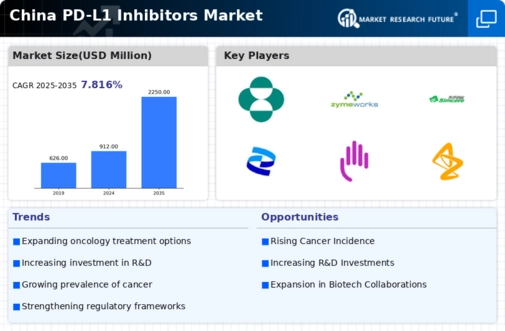The competitive landscape of the China PD-L1 Inhibitors Market is marked by a dynamic interplay of key players, driven by the increasing demand for innovative cancer therapies and advancements in immunotherapy. PD-L1 inhibitors have emerged as a crucial component in the treatment of various cancers, leading to intense competition among pharmaceutical companies that are striving to secure a foothold in this burgeoning market. Companies are focused developing effective therapies but also on navigating regulatory landscapes, establishing partnerships, and improving access to treatment for patients across China.
The ongoing research and development efforts, combined with strategic initiatives like collaborations and mergers, are shaping the future of the PD-L1 inhibitors segment, indicating a vibrant and rapidly evolving marketplace.
Focusing on Merck within the China PD-L1 Inhibitors Market, the company's presence is a testament to its commitment to advancing cancer care through innovative solutions. Merck has positioned itself as a leading player in the development of PD-L1 inhibitors, driven by robust research capabilities and an established pipeline of oncology products. The strengths of Merck in this region include its solid reputation for quality, extensive clinical data supporting its products, and a deep understanding of the Chinese therapeutic environment.
Additionally, Merck's established relationships with healthcare institutions and key opinion leaders facilitate its market penetration and accessibility to patients in need of novel cancer therapies, reinforcing its competitive edge in the highly structured regulatory landscape of China.
On the other hand, Portola Pharmaceuticals has made a strategic entry into the China PD-L1 Inhibitors Market with a focus on innovative therapeutic solutions. While the company's primary offerings are centered around transformational anticoagulation and hematology products, its engagement in the PD-L1 inhibitors space reflects a proactive stance on expanding its oncology portfolio. Portola Pharmaceuticals emphasizes its unique value propositions such as enhanced efficacy and safety profiles of its products, which resonate well with healthcare practitioners and patients alike. The company's strengthening presence in China has been bolstered by partnerships and collaborations that streamline distribution and enhance market access.
Although Portola is smaller compared to industry giants, it leverages its agility and innovation, aiming to carve a niche through targeted acquisitions and a focus on unmet medical needs within the Chinese oncology landscape.












